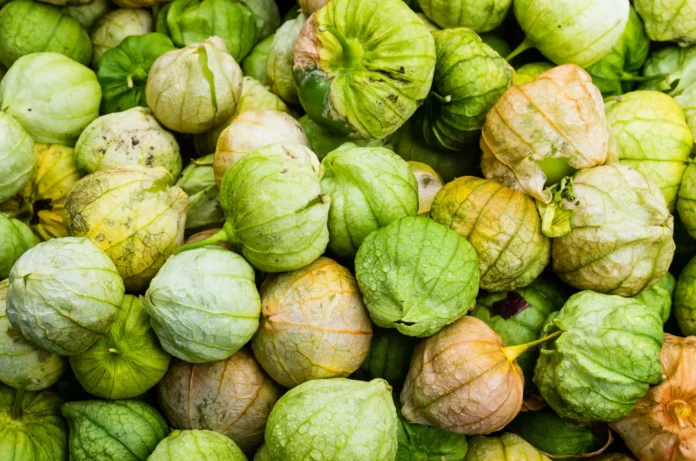The tomatillo (Physalis philadelphica or Physalis ixocarpa), also known as the Mexican husk tomato, is a small, round fruit native to Mexico and Central America. It is a member of the nightshade family (Solanaceae), closely related to tomatoes and peppers. The tomatillo is encased in a papery husk that turns brown and splits open as the fruit ripens. Its name derives from the Nahuatl word tomatl, which also influenced the word “tomato.”
Interesting Facts About The Tomatillo:
- Native to the Americas: Tomatillos are indigenous to Mexico and Guatemala, and have been cultivated for over 2,000 years. They are a staple in Mexican cuisine, and their use spread throughout the Americas and beyond
- Part of the Nightshade Family: Like tomatoes, tomatillos belong to the Solanaceae family. This means they are biologically related to potatoes, peppers, and eggplant. The family is known for some plants being toxic, but tomatillos themselves are completely edible
- Husk-Covered Fruit: Unlike tomatoes, which grow exposed on vines, tomatillos grow inside a thin, papery husk. This husk, which is technically a calyx, helps protect the fruit from pests and maintains its freshness
- Green When Harvested: While tomatillos can ripen into shades of yellow, purple, or red, they are most commonly harvested when green. At this stage, they have a tart, zesty flavor that is perfect for cooking into sauces like salsa verde
- Distinct Tangy Flavor: Tomatillos have a bright, tangy taste with a hint of citrus. This unique flavor makes them perfect for adding acidity and freshness to salsas, sauces, and other dishes
- Used in Salsa Verde: Salsa verde is one of the most iconic dishes made with tomatillos. The fruit is often roasted and blended with ingredients like cilantro, garlic, onions, and jalapeños to create this famous Mexican salsa
- Culinary Versatility: Tomatillos are not just for salsa; they are used in a wide variety of dishes, including soups (like sopa de tomatillo), stews (such as pollo con tomatillo), curries, and even tamales. They add a refreshing, tangy kick to any dish
- Mild When Cooked: When cooked, tomatillos lose their sharp tanginess and become softer and milder. This change makes them great for simmering into rich, flavorful sauces or adding depth to slow-cooked dishes
- Rich in Nutrients: Tomatillos are a good source of essential vitamins like vitamin C, as well as fiber and antioxidants. A single tomatillo can provide more than 10% of your daily recommended vitamin C intake
- Low in Calories: At only about 32 calories per 100 grams, tomatillos are a low-calorie food that provides a great way to add flavor and nutrition without a high energy cost
- High Water Content: Composed of roughly 92% water, tomatillos help with hydration. They are an excellent addition to fresh salads or blended drinks like aguas frescas
- Popular in Southwestern U.S.: While originally from Mexico, tomatillos have become a staple in southwestern U.S. cuisine, appearing in everything from tacos to chili to enchiladas
- Hard to Grow Outside Warm Climates: Tomatillos need a long growing season and plenty of warmth, making them difficult to grow in colder climates. They are best suited to USDA hardiness zones 5-10
- No Need for Pollination: Tomatillos are self-pollinating, but planting multiple tomatillo plants together can improve yield and quality. They rely on wind or insects for pollination
- Unripe When Best: Unlike many fruits, tomatillos are at their peak flavor and texture when unripe and green. As they ripen, they become sweeter and lose the tangy bite that makes them special
- Not a Tomato Substitute: Despite their similar appearance, tomatillos are not the same as green tomatoes. Their flavor profile is distinct, which is why they are used differently in cooking
- Sticky Skin: When the husk is removed, the tomatillo’s skin can be sticky, which is perfectly normal. This natural coating can be rinsed off under water before use
- Grows on Shrubs: Tomatillos grow on small, sprawling shrubs that can reach up to 3 feet (1 meter) tall. The plants are usually bushy and bear multiple fruit-bearing stems
- Easy to Store: Tomatillos can be stored in the fridge for a week or two if kept unpeeled. For long-term storage, they can be frozen once the husks are removed
- Ideal for Grilling: Tomatillos are perfect for grilling or roasting. The process intensifies their natural sweetness and adds a subtle smokiness to their flavor
- Often Mistaken for Green Tomatoes: Despite their resemblance to unripe tomatoes, tomatillos are not green tomatoes. They belong to a different genus and have a tangier, less sweet flavor
- Key Ingredient in Mexican Cuisine: Besides salsa verde, tomatillos are frequently used in stews, such as mole de tomatillo, and as a base for flavorful sauces served with tacos, grilled meats, and more
- Growing Popularity: Due to their health benefits and unique flavor, tomatillos have grown in popularity in markets outside of Latin America. You can now find them in grocery stores and farmer’s markets across the world
